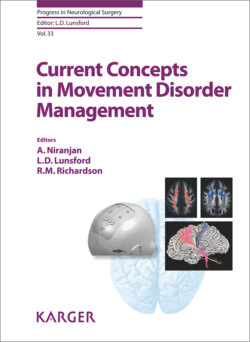Читать книгу Current Concepts in Movement Disorder Management - Группа авторов - Страница 11
Abstract
ОглавлениеThe first surgical procedures for abnormal movement disorders began in the 1930s, when surgeons first proposed ablative techniques of the caudate nucleus or transection of motor (pyramidal) pathways to reduce involuntary movements in patients with Parkinson’s related tremor. During the 50-year interval between 1945 and 1995, the development of precise intracranial guiding devices, brain maps, and advanced imaging led to the refinement of appropriate deep brain targets affecting extrapyramidal pathways. Lesional surgery and subsequent neuroaugmentation using deep brain stimulation extended the role of deep brain surgery for a wider group of patients with tremor, rigidity, dyskinesia, and other involuntary movement disorders. Stereotactic radiosurgery has had wide application for tremor. The history of movement disorder surgery reads like a who’s who of brilliant and resourceful surgeons who pushed the frontiers of neurosurgery. Even today, practitioners of functional brain surgery are among the most innovative practicing neurosurgeons.
© 2018 S. Karger AG, Basel
Brain surgery for movement disorders has been performed since the 1930s, beginning in an era when no effective medical options existed for patients with progressive tremor, rigidity, or other manifestations of degenerative disorders such as Parkinson’s disease. For detailed historical descriptions, the interested reader is referred to volume I of Lozano, Tasker, and Gildenberg’s comprehensive textbook on functional neurosurgery as a prelude to the additional reports in this volume of Progress in Neurological Surgery [1]. In the present report, the authors will provide a brief timeline as well as note important pioneers and milestones in the remarkable history of movement disorder brain surgery. If we do not study history, we and our patients are doomed to repeat it, especially in a field where failure to study the past leads to reinvention of the same methods evaluated 20–25 years earlier.
